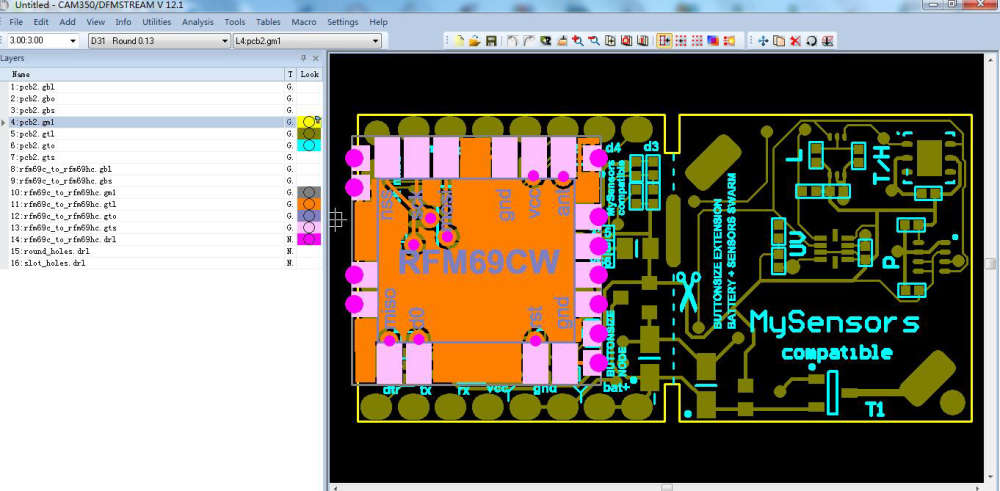💬 Button size radionode with sensors swarm extension
-
@pepson said in 💬 Button size radionode with sensors swarm extension:
And what is size gold pins ? 2.54 ?
Yes, 2.54
@pepson said in 💬 Button size radionode with sensors swarm extension:
And anybody what pin should be wire to activate programming... ? In arduino pro mini is dedicated micro switch. In this dont have microswitch and i want add microswitch. It should be RST connected to GND ? please help...
Programming is activated via DTR pin automatically.
@pepson said in 💬 Button size radionode with sensors swarm extension:
Can you share elemnts for version RFM69HW ? I see only PCB files but i dont know whatr i must have elements...
Schematic of the first version is available. Will share schematic version of ButtonSizeNode_V2 (with dc-dc) later.
-
But please share a list element what capacity and resistor and other and with what body. Ex 0805 etc.
But for programming i dont need push/wire RST with GND ?
Explaine me how works Programming is activated via DTR pin automatically ??
And what is ButtonSizeNode_V2 (with dc-dc) ?? What is diffrent to v1 ?
-
But please share a list element what capacity and resistor and other and with what body. Ex 0805 etc.
But for programming i dont need push/wire RST with GND ?
Explaine me how works Programming is activated via DTR pin automatically ??
And what is ButtonSizeNode_V2 (with dc-dc) ?? What is diffrent to v1 ?
@pepson said in 💬 Button size radionode with sensors swarm extension:
But for programming i dont need push/wire RST with GND ?
Explaine me how works Programming is activated via DTR pin automatically ??
No, no need to connect RST with GND.
DTR works automatically - as soon as you press upload in your Arduino IDE, it starts uploading the sketch to the atmega328p. Simple -
@pepson said in 💬 Button size radionode with sensors swarm extension:
And what is ButtonSizeNode_V2 (with dc-dc) ?? What is diffrent to v1 ?
https://github.com/EasySensors/ButtonSizeNode
https://github.com/EasySensors/ButtonSizeNode2@pepson said in 💬 Button size radionode with sensors swarm extension:
But please share a list element what capacity and resistor and other and with what body. Ex 0805 etc.
Will try to share soon. Almost all elements are 0402.
-
@pepson said in 💬 Button size radionode with sensors swarm extension:
And what is ButtonSizeNode_V2 (with dc-dc) ?? What is diffrent to v1 ?
https://github.com/EasySensors/ButtonSizeNode
https://github.com/EasySensors/ButtonSizeNode2@pepson said in 💬 Button size radionode with sensors swarm extension:
But please share a list element what capacity and resistor and other and with what body. Ex 0805 etc.
Will try to share soon. Almost all elements are 0402.
-
Ok please share list components... i wait for it.
And diffrent with v1 and v2 is only that v2 have two batteries ? -
Hi
Can you share your project file and file gerber with this specification
https://support.jlcpcb.com/article/44-how-to-export-kicad-pcb-to-gerber-filesOr can you put description to also file gerber ?
Thanks -
@pepson said in 💬 Button size radionode with sensors swarm extension:
Failed load project to production.
You mixed gerbers of the main board and adapter board.
@pepson said in 💬 Button size radionode with sensors swarm extension:
Please share also layer describe...
It is standard. If you really need it you can find layers description here
https://goo.gl/Jv33Lb (Generated Gerber Files)@pepson said in 💬 Button size radionode with sensors swarm extension:
Can you share your project file and file gerber with this specification
No I can't. Have no time today, sorry.
-
@pepson said in 💬 Button size radionode with sensors swarm extension:
Failed load project to production.
You mixed gerbers of the main board and adapter board.
@pepson said in 💬 Button size radionode with sensors swarm extension:
Please share also layer describe...
It is standard. If you really need it you can find layers description here
https://goo.gl/Jv33Lb (Generated Gerber Files)@pepson said in 💬 Button size radionode with sensors swarm extension:
Can you share your project file and file gerber with this specification
No I can't. Have no time today, sorry.
-
@koresh said in 💬 Button size radionode with sensors swarm extension:
You mixed gerbers of the main board and adapter board.
Can you explaine me more ? What can i do ?
-
Hi @koresh I'm having problems with battery monitor. Trying to find out what's wrong, I have realiced that A6 analog reads from regulator output. So It allways reports 3,3V, isn't it?
Also, I read that unregulated could go up to 6,5V. Wouldn't this destroy radio module? I think I'm missing something.
Thanks.

